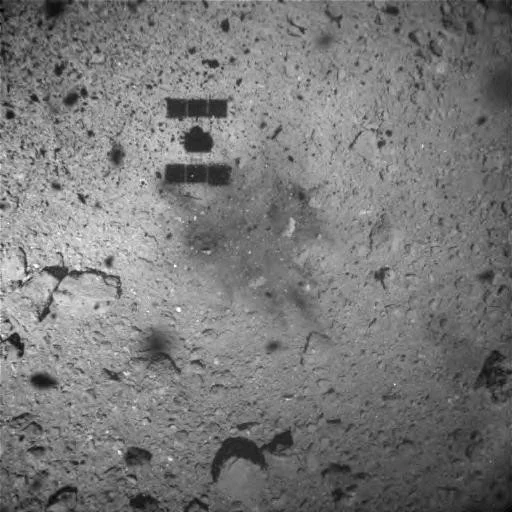“Don’t drink the water!” - Toxic Elements Found in Meteorites
A science team led by Alessondra Springmann found that heating up various types of carbonaceous chondrite meteorites released water as well as other volatile and toxic trace elements. Water is likely one of the very first resources that will be sourced from space for use in space. It is versatile for a variety of applications, including rocket propellant, consumption by astronauts, and bulk radiation shielding.
Ideally, asteroid processing systems would target sources of pure water that are easy to process and non destructive, yet that may be rare. The challenge now is identifying what components make up potential target asteroids and building systems that can accomodate potentially toxic material.
All meteorites that have impacted Earth were once asteroids or pieces of asteroids. Studying these meteorites helps unravel the story about the “parent” asteroid in space.
A piece of the Murchison meteorite is at The National Museum of Natural History (Washington). Some of the samples used in this study came from the Murchison meteorite, which fell near Murchison, Australia in 1969. Source: Art Bromage.
There are two major considerations for understanding the presence of water in asteroids. Was water present at formation? And how is water concentration affected by thermal alteration from its environment?
In general, the carbonaceous chondrite meteorites are primitive, having undergone the least amount of alteration and closely matching the chemical makeup of the solar nebula from which the Solar System formed. The CM and CI meteorites are sub-types of carbonaceous chondrites that are known to contain the highest concentration of water. There are still many discrepancies between the taxonomies of meteorites and asteroids. Spacecraft missions can look at asteroids up close and return samples to Earth for study, but meteorites are nature's cheapest version of "sample return".
The core aspect of the study focused on thermal alteration by measuring the release of certain trace elements as the meteorite was heated. Thermal alteration helps tell the story of a rock's journey through various processes in the evolution of the Solar System. Did this rock always reside in a small, primitive asteroid relatively unchanged for billions of years? Did it accrete into a larger planetessimal that partially melted or differentiated? Did it spend some time orbiting really close to the sun or did it migrate from further out? Each of these scenarios involves a distinct thermal environment, so understanding that history helps to piece together what happened to a meteorite in space before it impacted Earth.
There are notable similarities between the asteroid Bennu and carbonaceous chondrites meteorites. In fact, a co-author of this study is planetary scientist Dante Lauretta, the Principle Investigator of NASA’s OSIRIS-REx mission, which will return samples from the asteroid Bennu in 2023.
This image shows the wide variety of boulder shapes, sizes and compositions found on asteroid Bennu. There are notable similarities between the asteroid Bennu and carbonaceous chondrites meteorites. Credit: NASA/Goddard/University of Arizona.
“The results of these laboratory heating experiments, when combined with future laboratory measurements of abundances and depletions of labile elements in the returned sample, will help constrain the past orbital behavior of Bennu.”
Water is one of the first resources that companies are looking to process from asteroids. There are C-type asteroids observed in space which have diagnostic features indicating the presence of hydrated minerals and thought to be related to CM and CI type meteorites. These hydrated C-type asteroids are thought to contain between 2 and 22% water by mass.
Companies like TransAstra are developing technology to process that water using optical mining techniques. This involves pointing mirrors to concentrate sunlight towards asteroidal material that has been captured inside a bag enclosure. The asteroid surface is heated to the point where water is driven out and captured. However, this heating can be problematic because it also releases contaminants.
Some contaminants identified by this study include sulfur, arsenic, selenium, tellurium, cadmium, antimony, and mercury. The highest concentration of trace elements between all types of carbonaceous chondrites were sulfur and mercury, which exceeded the US Environmental Protection Agency's limits for contaminants in drinking water.
Aside from human toxicity, these trace elements in unfiltered water may corrode and cause brittle fracture in platinum or aluminum components, which are common in various types of filtration systems, electrolyzers, and rocket thrusters. Any systems designed for handling or purifying asteroid water will need to account for trace elements.
"For future in-situ resource utilization, future work is needed to enable purification of water from heavy metals and sulfur without damaging the purification apparatus."
References
Springmann, Alessondra, et al. "Thermal alteration of labile elements in carbonaceous chondrites." Icarus 324 (2019): 104-119. DOI: 10.1016/j.icarus.2018.12.022. Link: https://arxiv.org/abs/1810.04154.
Author
David Rich is a geologist by academic training and petroleum exploration data manager by profession. He’s passionate about space exploration and enabling the expansion of humanity’s economic sphere into the Solar System. For more asteroid-related content, check out Asteroid Analytics or connect on Twitter @asteroidanalyst and @rockyboulders.










